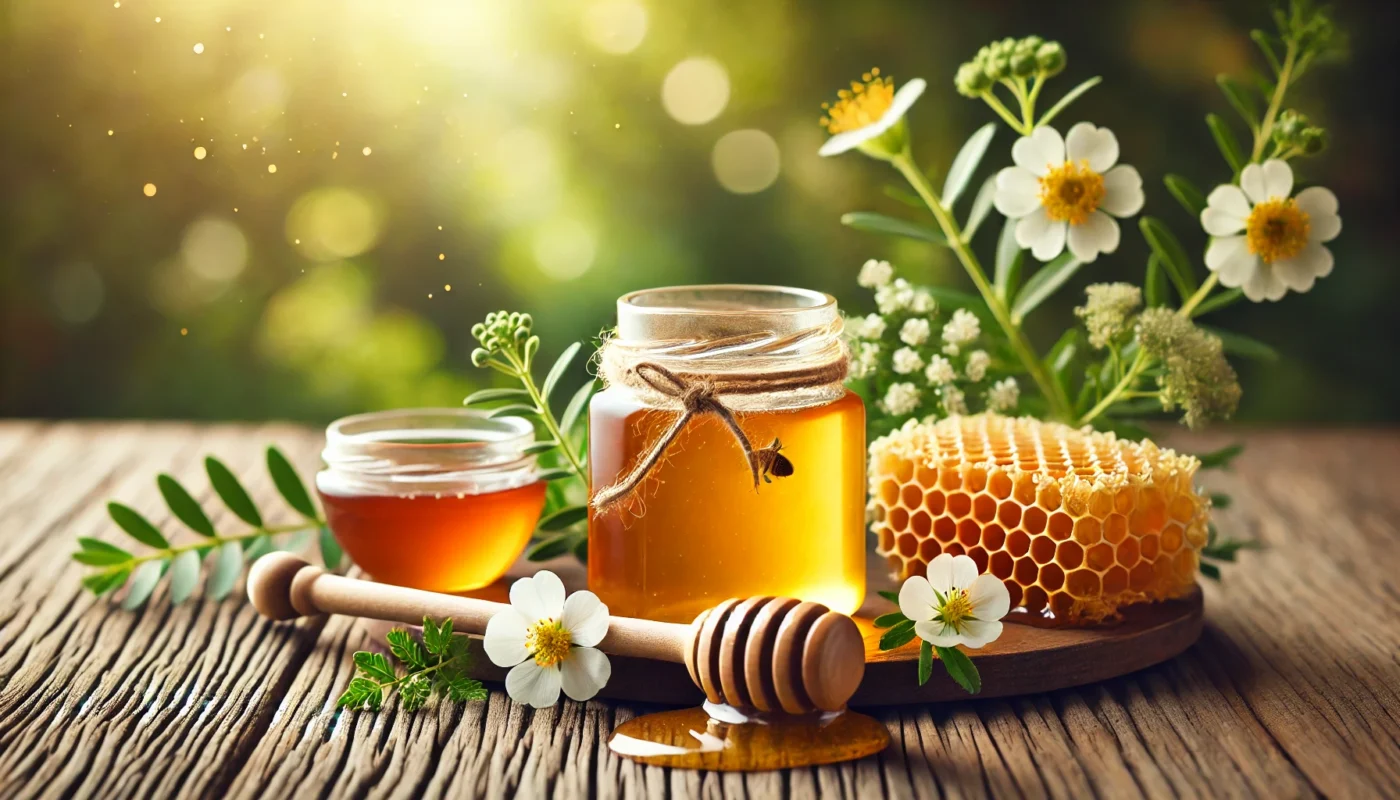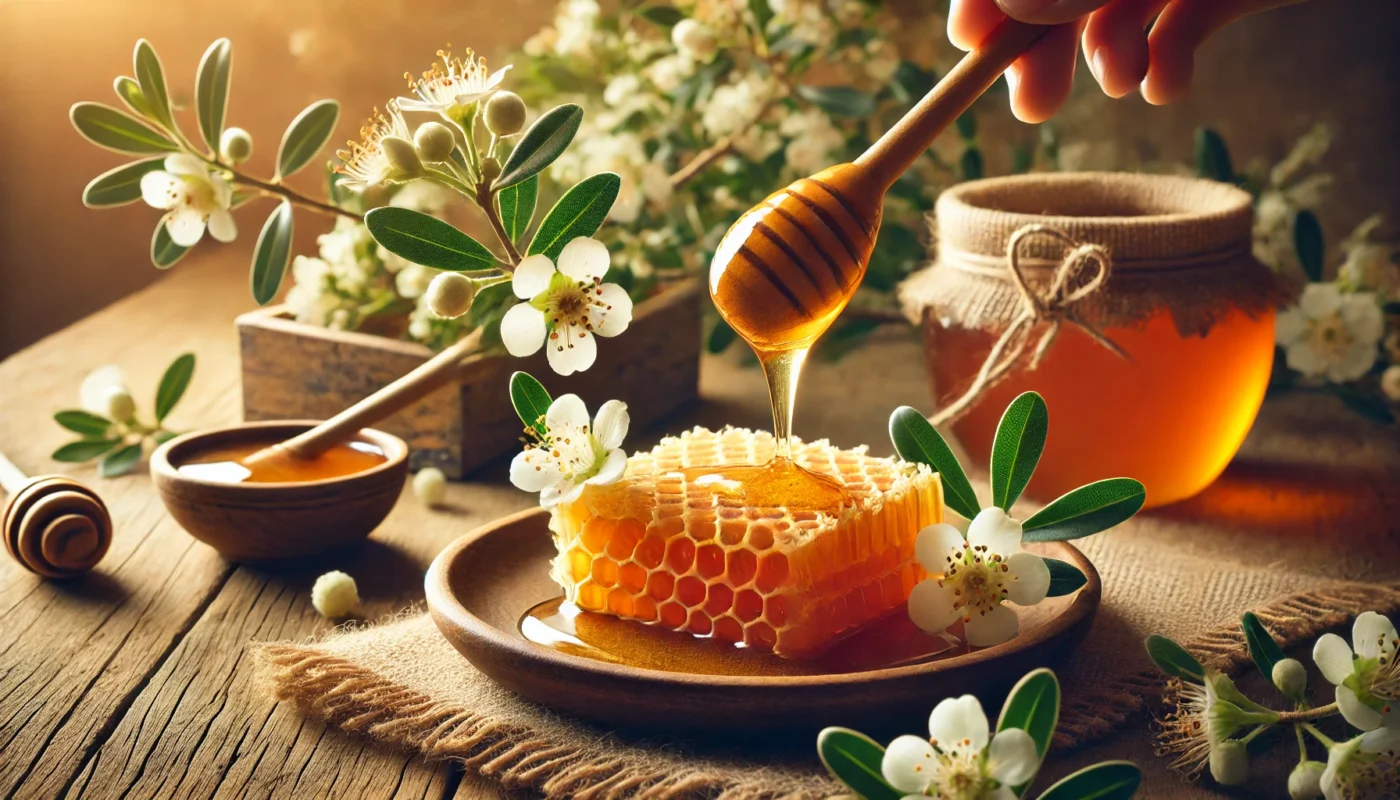Originating from New Zealand, Manuka honey is produced by bees that pollinate the native Manuka bush. Unlike regular honey, Manuka honey contains a higher concentration of methylglyoxal (MGO), a compound believed to be responsible for its potent antibacterial properties. This honey also boasts a unique Manuka factor (UMF), a grading system that indicates the level of its antibacterial activity. Understanding these components helps consumers make informed decisions when selecting Manuka honey for therapeutic use.
You may also like: Home Remedies: Fight Cut Infections Naturally
The Unique Composition of Manuka Honey
Manuka honey’s exceptional healing qualities are attributed to its rich composition of active ingredients. Beyond MGO, it contains hydrogen peroxide, leptosperin, and dihydroxyacetone (DHA). These compounds work synergistically to offer a multifaceted approach to healing, making Manuka honey a powerful natural remedy. Each element plays a specific role; hydrogen peroxide offers mild antiseptic properties, while leptosperin contributes to its stability and effectiveness. Dihydroxyacetone is found in the nectar of Manuka flowers and converts to MGO, enhancing the honey’s antibacterial potency.
The Role of Methylglyoxal
Methylglyoxal (MGO) is the compound that sets Manuka honey apart from other types of honey. It forms naturally in the honey when DHA, present in the nectar of the Manuka flower, undergoes a chemical transformation. This process gives Manuka honey its distinctive antibacterial strength. Research shows that higher MGO concentrations correlate with greater antibacterial effects, making the UMF rating a crucial tool for consumers seeking therapeutic honey.
Understanding the Unique Manuka Factor (UMF)
The Unique Manuka Factor (UMF) is a grading system that measures the antibacterial strength of Manuka honey. It assesses the concentration of MGO, DHA, and leptosperin, providing a reliable indicator of quality. A higher UMF rating signifies a more potent honey, suitable for medical and therapeutic applications. Consumers should look for a UMF rating of 10 or above to ensure they are purchasing honey with significant healing potential.
Manuka Honey Benefits for Wound Healing
Manuka honey’s application in wound healing is supported by a growing body of scientific research. Let’s explore how it facilitates this process, from antibacterial actions to supporting tissue regeneration. Its benefits extend beyond traditional wound care, offering potential solutions for various skin conditions and infections.
Antibacterial Properties
One of the most significant benefits of Manuka honey is its potent antibacterial effects. The MGO in Manuka honey disrupts bacterial cell walls, inhibiting growth and promoting a sterile environment that is conducive to healing. This is particularly beneficial for wounds at risk of infection, as Manuka honey can combat a broad spectrum of bacteria, including antibiotic-resistant strains like MRSA. Its ability to target and neutralize these pathogens makes it a valuable tool in both preventing and treating infections.
Anti-inflammatory and Antioxidant Effects
Chronic inflammation can impede the healing process, but Manuka honey offers anti-inflammatory benefits that help to reduce swelling and pain. Its antioxidant properties also protect tissues from oxidative stress, further supporting the healing environment. By reducing free radicals, Manuka honey helps to minimize tissue damage and promote faster recovery. These properties are especially beneficial in treating conditions like eczema and psoriasis, where inflammation plays a significant role.
Promoting Tissue Regeneration
Research indicates that Manuka honey can accelerate tissue regeneration and wound closure. It does so by stimulating the production of collagen, a crucial protein in skin repair, which helps wounds heal faster and with less scarring. This makes it an attractive option for post-surgical wounds and burns, where minimizing scar formation is a priority. Moreover, its moisturizing properties ensure that healing occurs in a hydrated environment, further aiding in skin restoration.
Additional Skin Benefits
Beyond wound healing, Manuka honey is increasingly recognized for its potential in treating various skin issues. Its natural humectant properties help maintain skin hydration, making it beneficial for dry or dehydrated skin. Additionally, its ability to balance skin pH and provide gentle exfoliation can improve overall skin texture and appearance. These qualities make it a popular ingredient in skincare products aimed at achieving healthy, radiant skin.

How to Apply Manuka Honey on Wounds
Applying Manuka honey to wounds is straightforward, but it requires attention to detail to maximize its healing potential. Here’s a step-by-step guide, along with tips for ensuring optimal results. Proper application not only enhances its effectiveness but also ensures safety and hygiene during the healing process.
Step-by-Step Application Guide
- Clean the Wound: Begin by gently cleaning the wound with mild soap and water. Pat the area dry with a clean towel. This step is crucial to remove debris and reduce the risk of contamination, setting a clean base for the honey application.
- Apply the Honey: Using a sterile applicator, such as a cotton swab or clean fingers, apply a thin layer of Manuka honey directly onto the wound. Ensure the honey covers the entire affected area. The thickness of the layer should be sufficient to stay in place but not so thick that it hinders air circulation.
- Cover with a Dressing: Place a sterile gauze or bandage over the honey-coated wound to keep the area protected and to prevent the honey from being wiped away. This not only secures the honey in place but also adds a layer of protection against external contaminants.
- Change the Dressing Regularly: For optimal results, change the dressing daily or whenever it becomes saturated or soiled. Reapply fresh Manuka honey with each dressing change. Regular changes prevent bacterial buildup and ensure the wound remains in an optimal healing environment.
How Long Do You Leave Honey on a Wound?
The duration for which Manuka honey should be left on a wound varies depending on the severity and type of wound. Generally, it is advisable to leave the honey in place until the next dressing change, typically every 24 hours. However, in cases of more severe wounds, more frequent application may be necessary as advised by a healthcare professional. Monitoring the wound’s progress and consulting with a healthcare provider can help determine the best application schedule.
Special Considerations for Different Wound Types
Different types of wounds may require specific considerations when using Manuka honey. For chronic wounds, such as diabetic ulcers, more frequent application and monitoring may be necessary to track progress and prevent complications. In cases of burns, the cooling and soothing properties of Manuka honey can provide additional comfort, but careful application is needed to avoid disrupting the delicate tissue.
Tips for Enhanced Application
For those seeking to maximize the benefits of Manuka honey, consider incorporating other natural remedies such as aloe vera or coconut oil, which can complement honey’s healing properties. Additionally, maintaining a balanced diet rich in vitamins C and E can support the body’s natural healing processes, working synergistically with topical treatments. Always ensure the honey used is genuine Manuka honey with an appropriate UMF rating to guarantee its therapeutic efficacy.

Scientific Studies and Evidence
The therapeutic effects of Manuka honey are supported by numerous scientific studies. Research published in the Journal of Wound Care demonstrated the efficacy of Manuka honey in reducing wound size and promoting faster healing compared to conventional treatments. Another study in the International Journal of Lower Extremity Wounds highlighted its effectiveness in managing diabetic ulcers. These studies provide a solid foundation for Manuka honey’s role in wound care and encourage further exploration into its applications.
Clinical Trials and Research Findings
Clinical trials have consistently shown that Manuka honey can significantly improve healing rates in various wound types. Its efficacy in reducing bacterial load and promoting tissue regeneration has been documented in numerous peer-reviewed journals. These findings support the integration of Manuka honey into standard wound care protocols, particularly for chronic and hard-to-heal wounds.
Mechanisms of Action
Understanding the mechanisms by which Manuka honey exerts its healing effects is crucial for its effective application. Studies suggest that its antibacterial properties stem from the high MGO content, which disrupts bacterial cell walls and inhibits growth. Additionally, its anti-inflammatory and antioxidant actions contribute to a supportive healing environment, reducing tissue damage and promoting recovery.
Ongoing Research and Future Prospects
While more research is needed to fully understand the mechanisms at play, the existing evidence underscores Manuka honey’s potential as a complementary treatment for wound care. Ongoing studies are exploring its applications in other areas, such as combating acne, treating gastrointestinal issues, and even as a natural preservative in food products. These investigations continue to reveal new dimensions of Manuka honey’s therapeutic potential, expanding its use beyond traditional applications.
Practical Advice and Considerations
While Manuka honey presents a promising natural treatment, it’s essential to consider a few practical aspects. Understanding these considerations ensures that users can effectively and safely incorporate Manuka honey into their healing regimen. From selecting the right product to knowing when to seek professional advice, these tips can enhance the therapeutic experience.
Quality Matters
Not all Manuka honey is created equal. Look for products with a UMF rating of 10 or higher to ensure therapeutic potency. This rating guarantees that the honey has been independently tested and verified for its methylglyoxal content, ensuring its effectiveness. Purchasing from reputable sources and checking for certification labels can help consumers avoid counterfeit or diluted products.
Consult a Professional
For chronic or severe wounds, consult a healthcare professional before using Manuka honey as a treatment. It should complement, not replace, conventional medical care. Healthcare providers can offer guidance on integrating Manuka honey into a comprehensive treatment plan, ensuring its safe and effective use. Professional advice is particularly crucial for individuals with underlying health conditions that may affect wound healing.
Allergies and Sensitivities
Individuals allergic to bees or pollen should exercise caution when using Manuka honey, as it may trigger allergic reactions. Conducting a patch test before full application can help identify potential sensitivities. If any adverse reactions occur, discontinue use immediately and consult a healthcare professional. Awareness of personal allergies and monitoring for signs of sensitivity are essential for safe use.
Storage and Handling
Proper storage and handling of Manuka honey ensure its longevity and effectiveness. Store honey in a cool, dry place away from direct sunlight to preserve its active compounds. Use clean utensils to avoid contamination and maintain its purity. Following these guidelines helps maintain the honey’s therapeutic properties, ensuring it remains effective for future applications.

Conclusion
The science behind Manuka honey healing is compelling, offering a natural alternative for those seeking holistic approaches to health and wellness. Its antibacterial, anti-inflammatory, and tissue-regenerative properties make it a valuable tool in wound care. By understanding how to properly apply and utilize Manuka honey, you can harness its full potential to support your healing journey. Embrace the power of nature with Manuka honey and explore the possibilities it offers for improved health and well-being. As research continues to unveil its diverse applications, Manuka honey remains a promising option in the realm of natural medicine, bridging the gap between traditional remedies and modern therapeutic practices.
Further Reading:
Is Manuka honey really a superfood?
Manuka honey, wound care, natural remedies, healing properties, antibacterial, anti-inflammatory, tissue regeneration, clinical trials, health and wellness, holistic health, diabetic ulcers, skin care, allergies, natural treatments, therapeutic applications, MGO content
Important Note: The information contained in this article is for general informational purposes only, and should not be construed as health or medical advice, nor is it intended to diagnose, prevent, treat, or cure any disease or health condition. Before embarking on any diet, fitness regimen, or program of nutritional supplementation, it is advisable to consult your healthcare professional in order to determine its safety and probable efficacy in terms of your individual state of health.
Regarding Nutritional Supplements Or Other Non-Prescription Health Products: If any nutritional supplements or other non-prescription health products are mentioned in the foregoing article, any claims or statements made about them have not been evaluated by the U.S. Food and Drug Administration, and such nutritional supplements or other health products are not intended to diagnose, treat, cure, or prevent any disease.

